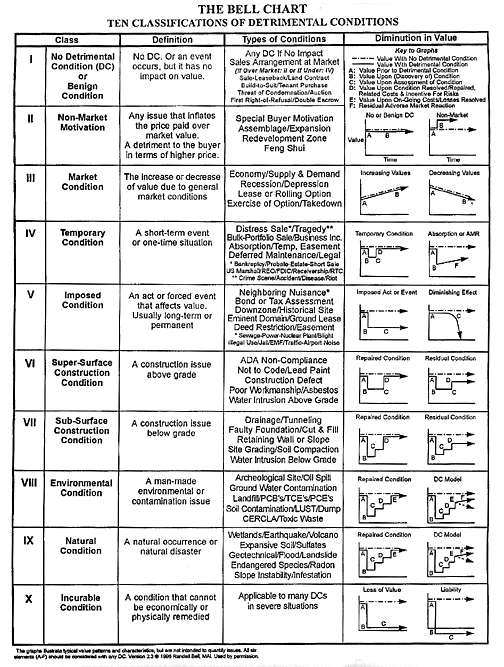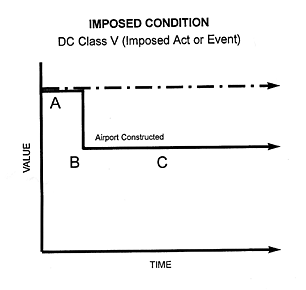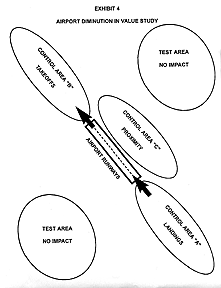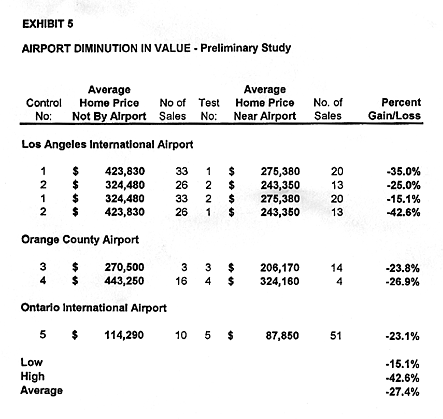
Airport Diminution in Value
The following document was submitted to the Orange County Board of Supervisors by Randall Bell, MAI. Mr. Bell is the principal of Bell & Associates, Inc. Of Santa Monica and Laguna Niguel. He holds an MBA in Real Estate from UCLA, is a Certified General Real Estate Appraiser and a Licensed Real Estate Broker. Mr. Bell is an instructor for the Appraisal Institute, was the Chair of the Litigation Seminar in 1994 and 1995 and has published numerous articles in various legal and professional publications. Information in this letter is also included in an article entitled Ten Standard Classifications of Detrimental Conditions published in Right of Way magazine.
January 9, 1997
Orange County Board of Supervisors,
10 Civic Center Plaza
Santa Ana, California 92702
Re: Proposed International Airport Use El Toro Marine Base Our File: 96-55
Gentlemen:
Utilizing standard valuation methodologies and market data, I have made a preliminary analysis in order to determine the diminution in value, if any, to properties located in proximity to the proposed international airport on the El Toro Marine Base site.
The Environmental Management Agency Staff Report, page 13, and dated November 21, 1996 states in part:
While some researchers have conducted "valuation" studies in areas around airports in the United States, these studies have little, if any, application to the circumstances projected for the proposed project... Such studies are frequently statistical studies which make little or no attempt to normalize the data for property specific factors. This makes it extremely difficult to isolate airport noise (or even airport proximity) as the causation factor in any conclusions regarding effects on value.
The report further states:
In these areas, proximity to an airport may have certain positive effects on residential property values. These may include extensive transportation network improvements, accessibility to jobs because airports are typically employment centers, and reduction in general travel costs. Hence, the net effect on housing prices may not be negative.
No market data is presented to support these comments. Apparently this report has drawn the conclusion that it is not possible to access any impact caused by airports, yet then accesses that the impact may be positive.
The statements contained within the EIR are based on something other than generally accepted valuation methodologies. The most fundamental aspect of real estate valuation studies is that conclusions must be based upon market data. Relative to many detrimental conditions such as environmental contamination, geotechnical issues and natural disasters, airport noise is very straight-forward to study and assess. Isolating a single component of value, such as airport noise and proximity, is a familiar and routine procedure.
Our firm has been involved in the study of diminution in value for many years. In the course of this work, we have developed a chart which categorizes over 200 types of conditions that impact real estate values. These findings have been published and have been presented in seminars sponsored by various professional organizations. This chart sets forth these classifications of various Detrimental Conditions (DCs) and is set forth as Exhibit 1. Airport proximity is categorized as a "Class V DC", which is the classification given to DCs involving Imposed Conditions.

 The basic premise of diminution in value
issues is depicted by the Detrimental Condition Model, as set forth as Exhibit
2. This model basically illustrates that there are six considerations
that must be made when quantifying the diminution in value due to a DC.
These are outlined as follows:
The basic premise of diminution in value
issues is depicted by the Detrimental Condition Model, as set forth as Exhibit
2. This model basically illustrates that there are six considerations
that must be made when quantifying the diminution in value due to a DC.
These are outlined as follows:
(A) The value of properties in an undamaged condition.
(B) The value upon the occurrence of a DC.
(C) The costs to assess the situation. These costs typically occur when engineering studies are required to access environmental or geotechnical issues.
(D) The costs to repair and remediate the problems. Many DCs require repairs or remediation, such as construction defects, environmental contamination, etc.
(E) The costs of any on-going conditions or monitoring. For example, a flood-damaged property may incur the costs of maintaining a revetment or levy, and a contaminated property may require on-going monitoring. Construction defects, with the exception of encapsulated or enclosed asbestos, do not typically incur such costs. (F) The discount or incentive to entice a prospective buyer to purchase a previously damaged property. This reflects the discount for the risks, contingencies and trouble to which a buyer is exposed when purchasing a damaged property. This is sometimes termed "residual adverse market reaction" or "stigma".
As stated, airport noise is a Class V DC. Compared to Class VI through Class X DCs, Class V DCs are relatively simple to assess as they require only the measurement of two points, as opposed to six. These two points are "A" the value as if there is no DC and, "B" the value upon the DC occurring. This concept is illustrated within Exhibit 3.
This preliminary study is accomplished by the utilization of a "paired-sales analysis", whereby paired sets of data are compared to each another. The basic market data search perimeters are set forth as Exhibit 4. As this exhibit illustrates, the objective is to examine sales comparables that are similar in all respects except for their airport proximity.


In this preliminary study, single-family residences containing from 1,500 to 2,000 SqFt (except Ontario which contained from 1,000 to 1,500 SqFt), have similar lot sizes and sold within the last six months. Further, the homes are all located in the same or similar nearby communities. By utilizing these search perimeters, virtually all non-airport elements of value are eliminated, such as the size of the improvements, location, market conditions, etc. In all, 190 sales comparables were studied. The results of this paired-sales analysis are summarized on Exhibit 5.

This study indicates that airport proximity consistently has a negative impact on value. This market data indicates that single family residences located in proximity to an airport are worth less than an otherwise similar property that is not located by an airport. This impact on value ranges from -15.1% to -42.6% and averages -27.4%.
Office Market Study
As part of this preliminary study, I have reviewed secondary market data related to the LAX office market. It is well known within the real estate community that the LAX market is the lowest in terms of rental rates of any office market in the region. This is in spite of the office market having outstanding freeway and airport access, and the office improvements themselves being comparable with other office buildings in the area.
The LAX office market is distinct from other markets in that many of the office buildings are located on Century Boulevard directly under the airport's final landing approach. These office buildings have similar features and amenities and are otherwise comparable with other office buildings throughout Southern California, except these office buildings are subjected to considerable noise and related airport issues. The LAX office market has an average effective rental rate of $0.85/SqFt. Other office buildings within the South Bay office market have average effective rental rates ranging from $1.05/SqFt to $1.50/SqFt. The rental rates for the LAX office market range from 19.1% to 43.3% lower than any other market in the surrounding South Bay area. Combined with the effects of also having the highest vacancy rate of 38.1%, the negative net impact on value is further amplified. A comparative summary of rental rates and vacancy rates are set forth within Exhibit 6.
Submarket |
Rentable |
Vacant |
% Vacant Direct |
Net |
Effective Rent |
| El Seg/Man Bch | 9,295 | 1,933 | 20.8% | -330 | $1.50 |
| Torrance Frwy | 3,291 | 1,070 | 32.5% | -266 | $1.35 |
| Torrance Central | 3,255 | 629 | 19.3% | 80 | $1.40 |
| Carson | 1,621 | 330 | 20.4% | 45 | $1.05 |
| LAX/Century Bl | 4,198 | 1,599 | 38.1% | - 70 | $0.85 |
| Long Beach Sub | 4,278 | 615 | 14.4% | 458 | $1.35 |
| Long Beach Dtwn | 3,826 | 996 | 26.0% | -120 | $1.40 |
| South Bay Total | 29,763 | 7,171 | 24.1% | -203 | $1.28 |
Source: Grubb & Ellis 1996 Real Estate Forecast
Note: 1995 numbers include estimates for the forth quarter that were derived
in early December.
The market data from this preliminary study indicates the following:
1. National and international airports impact the values on properties in close proximity.
2. The impact on single-family residences located in proximity to an airport is consistently negative, as compared to otherwise similar properties not located near an airport.
3. The impact on single family residences ranges from -15.1% to -42.6%, and averages -27.4%. This does not include the costs of noise mitigation measures that individual homeowners may incur.
Additional studies could refine and better delineate this impact, and it should be noted that various degrees of impact exist that this preliminary study does not address. For example, properties in closer proximity to a airport are more significantly impacted as opposed to those properties located further away. Additionally, there may be distinctions between locations on the final landing, takeoff and side-proximity that this preliminary study does not address.
4. The LAX office market enjoys outstanding transportation access and the improvements are comparable with other office buildings in the area; however, this market is distinct in that it is located under the final landing approach to an international airport. The rental rates for the LAX office market are from 19.1% to 43.3% lower than any other office market in the surrounding South Bay area. Combined with the effects of also having the highest vacancy rate of 38.1%, the negative net effects on value are further amplified. These figures do not include any special noise mitigation costs incurred by the property owners.
Real estate valuations and diminution in value studies are meaningful only if based upon market data. From the perspective of a real estate analyst, making value judgments or reaching conclusions without market data support is irresponsible at best. While this is only the simplest of studies, I hope that this report will serve as a beginning point for all parties to focus on meaningful market data as a basis for their findings.
Very truly yours,
Randall Bell, MAI